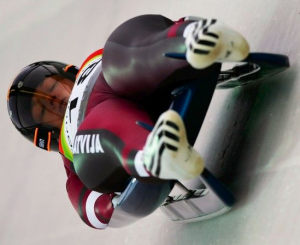
Latvian luger Guntis Rēķis slides down the track. Rēķis said given the high speed, every ride down the Vancouver track was a fight for survival.
RIGA — Latvian lugers have confirmed what the tragic death of a Georgian athlete has led many to suspect — that the Vancouver track is too dangerous.
“All our lugers complained about the track in Vancouver during initial trial runs in November,” said Dace Gods, secretary general of the Latvian Luge Federation.
She said they described the track as “very fast” and “not allowing for the smallest mistake.”
Gods said the Vancouver track allowed lugers to reach [private_supervisor]speeds of up to 145 kilometers per hour (90 miles per hour), which she said was “quite dangerous.”
By comparison, the Sigulda luge track, which was build during the Soviet era in accordance to a Yugoslavian design, lets athletes cruise at 120 kilometers per hour — or about 20 percent slower than in Vancouver.
Fears about the dangers of the Vancouver track turned to tragedy after Georgian luger flew off his sled and slammed into a steel supporting bar. Nodar Kumaritashvili, 21, died in the incident.
The International Luge Federation and Olympic officials in Canada faulted the Georgian, saying he failed to compensate after coming out late of the next-to-last turn.
Critics, however, said the track was still too challenging technically and demanded more practice time, a luxury only Canadian lugers were afforded. Guntis Rēķis, an award-winning Latvian luger, said every ride on the Vancouver track was a fight for survival, according to Gods.
[/private_supervisor] [private_subscription 1 month]speeds of up to 145 kilometers per hour (90 miles per hour), which she said was “quite dangerous.”
By comparison, the Sigulda luge track, which was build during the Soviet era in accordance to a Yugoslavian design, lets athletes cruise at 120 kilometers per hour — or about 20 percent slower than in Vancouver.
Fears about the dangers of the Vancouver track turned to tragedy after Georgian luger flew off his sled and slammed into a steel supporting bar. Nodar Kumaritashvili, 21, died in the incident.
The International Luge Federation and Olympic officials in Canada faulted the Georgian, saying he failed to compensate after coming out late of the next-to-last turn.
Critics, however, said the track was still too challenging technically and demanded more practice time, a luxury only Canadian lugers were afforded. Guntis Rēķis, an award-winning Latvian luger, said every ride on the Vancouver track was a fight for survival, according to Gods.[/private_subscription 1 month] [private_subscription 4 months]speeds of up to 145 kilometers per hour (90 miles per hour), which she said was “quite dangerous.”
By comparison, the Sigulda luge track, which was build during the Soviet era in accordance to a Yugoslavian design, lets athletes cruise at 120 kilometers per hour — or about 20 percent slower than in Vancouver.
Fears about the dangers of the Vancouver track turned to tragedy after Georgian luger flew off his sled and slammed into a steel supporting bar. Nodar Kumaritashvili, 21, died in the incident.
The International Luge Federation and Olympic officials in Canada faulted the Georgian, saying he failed to compensate after coming out late of the next-to-last turn.
Critics, however, said the track was still too challenging technically and demanded more practice time, a luxury only Canadian lugers were afforded. Guntis Rēķis, an award-winning Latvian luger, said every ride on the Vancouver track was a fight for survival, according to Gods.[/private_subscription 4 months] [private_subscription 1 year]speeds of up to 145 kilometers per hour (90 miles per hour), which she said was “quite dangerous.”
By comparison, the Sigulda luge track, which was build during the Soviet era in accordance to a Yugoslavian design, lets athletes cruise at 120 kilometers per hour — or about 20 percent slower than in Vancouver.
Fears about the dangers of the Vancouver track turned to tragedy after Georgian luger flew off his sled and slammed into a steel supporting bar. Nodar Kumaritashvili, 21, died in the incident.
The International Luge Federation and Olympic officials in Canada faulted the Georgian, saying he failed to compensate after coming out late of the next-to-last turn.
Critics, however, said the track was still too challenging technically and demanded more practice time, a luxury only Canadian lugers were afforded. Guntis Rēķis, an award-winning Latvian luger, said every ride on the Vancouver track was a fight for survival, according to Gods.[/private_subscription 1 year]
— This is a paid article. To subscribe or extend your subscription, click here.












